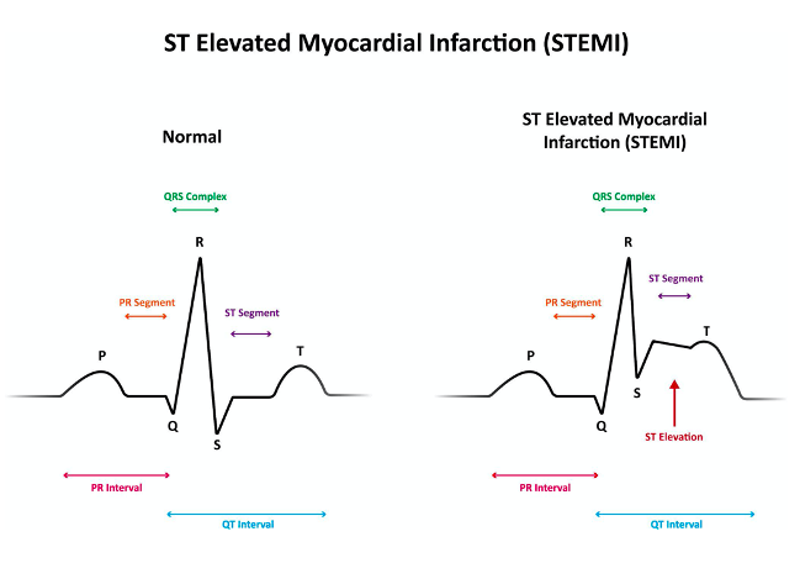Expand all
Collapse all
Overview
One in eight men and one in fifteen women die from coronary heart disease in the UK (British Heart Foundation, 2022).
Acute coronary syndrome (ACS) is an acute presentation of coronary heart disease, encompassing:
1. ST–elevation myocardial infarction (STEMI)
2. Non–ST elevation myocardial infarction (NSTEMI)
3. Unstable angina
Myocardial infarctions (MIs) are known as ‘heart attacks’ (British Heart Foundation, 2022).
To view the rest of this content login below; or read sample articles.
Symptoms
Chest pain or discomfort is the most common symptom.
Other symptoms include:
- Jaw pain
- Neck pain
- Arm pain
- Lightheadedness
- Nausea
- Vomiting
- Sweating and/or clamminess
- Shortness of breath (NHS, 2022).
The range of symptoms makes diagnosis challenging, as they are present in other conditions, including anxiety, musculoskeletal and respiratory conditions.
NICE (2021) recommends establishing the following to guide the diagnosis:
- The nature of the pain - cardiac pain is commonly of acute onset, described as a central chest pain, with radiation to the jaw, arms or back.
- Exacerbating and relieving factors - cardiac pain is commonly worse on exertion (angina), although can occur at rest.
- Associated symptoms - cardiac pain may be associated with shortness of breath, nausea or vomiting.
- Cardiovascular history and risk factors - patients presenting with cardiac chest pain may have a history of cardiovascular disease. Patients may have cardiovascular risk factors (diabetes, smoking, alcohol excess, raised
To view the rest of this content login below; or read sample articles.
Aetiology
Atherosclerosis is the process whereby fatty plaques (atheroma) build up in the lining of the arteries. The atheroma can break off, causing clots (thrombosis) which disrupt the blood supply to body tissues (ischaemia) (NHS, 2019).
In coronary artery disease, atherosclerosis affects the heart muscle itself (the myocardium) (Longmore et al, 2014).
ACS is caused by myocardial ischaemia.
1. Unstable angina
Angina is pain caused by ischaemia. Stable angina occurs only on exertion (NHS, 2021).
Unstable angina is ischaemia at rest or on minimal exertion. It is associated with an increased risk of MI (Baruah and Hartley, 2022a).
2. Myocardial infarction
An MI is myocardial cell death due to prolonged ischaemia (Thygesen et al, 2007).
Typically, a STEMI occurs where there is complete occlusion of a coronary artery. Whereas, an NSTEMI occurs as a consequence of near complete occlusion (Baruah and Hartley, 2022b).
To view the rest of this content login below; or read sample articles.
Diagnosis
Myocardial infarction
An MI is defined as a rise in cardiac biomarkers (blood test), with either symptoms of ischaemia, ECG findings or evidence of ischemia on further imaging (NICE, 2014).
STEMI
ST segment elevation in two contiguous leads of any ECG is indicative of a STEMI, as demonstrated in Figure 1 (Thygesen et al, 2007).

Non-ST-elevation myocardial infarction
NSTEMI does not feature ST elevation on the ECG. It is the most prevalent presentation of ACS in the UK (Nadarajah and Gale, 2021).
Diagnosis is made via high sensitivity cardiac biomarkers, namely troponins I and T, which measure cardiac cell death. Troponin values vary depending on the type of test used (NICE, 2020).
The European Society of Cardiology
To view the rest of this content login below; or read sample articles.
Management
Acute management
All patients with a suspected ACS should receive:
- Oxygen to maintain oxygen saturations of 94-98% (or 88-92% in patients with chronic obstructive pulmonary disorder)
- Pain relief- usually morphine or GTN
- Aspirin 300mg (NICE, 2016)
Reperfusion of the coronary artery is key. This is achieved by fibrinolysis or primary percutaneous coronary intervention (PPCI).
- Coronary angiogram allows visualisation of blockages and narrowing in the coronary arteries via x-ray. A thin tube (catheter) is inserted into a peripheral blood vessel, a contrast medium is injected and x-ray images taken (NHS, 2018).
- PPCI, or angioplasty, uses coronary angiogram to insert a stent into the coronary artery. This allows the narrowed blood vessel to enlarge, enabling reperfusion (Royal Papworth Hospital NHS Foundation Trust, 2022).
- Streptokinase, alteplase, reteplase and tenecteplase are thrombolytic drugs licensed for use in acute MI (BNF, 2022).
PPCI is the method of choice for treatment of STEMI (European Society of
To view the rest of this content login below; or read sample articles.
Resources
References
Baruah R, Hartley A. Unstable Angina. 2022a. https://bestpractice.bmj.com/topics/en-gb/3000100 (accessed 18 November 2022)
Baruah R, Hartley A. Non ST elevation MI, 2022b. https://bestpractice.bmj.com/topics/en-gb/3000113#:~:text=Summary,demonstrated%20by%20elevation%20in%20troponin (accessed 18 November 2022)
BNF. Treatment Summaries, Fibrinolytic drugs. https://bnf.nice.org.uk/treatment-summaries/fibrinolytic-drugs/#:~:text=Related%20drugs-,Overview,licensed%20for%20acute%20myocardial%20infarction (accessed 17th August 2022)
British Heart Foundation. UK CVD fact sheet. 2022. hf.org.uk/-/media/files/research/heart-statistics/bhf-cvd-statistics---uk-factsheet.pdf (accessed 8th August 2022)
Collet J-P, Thiele H, Barbato E et al. 2020 ESC Guidelines for the management of acute coronary syndromes in patients presenting without persistent ST-segment elevation. Eur Heart J. 2021;42(14):1289-1367. https://doi.org/10.1093/eurheartj/ehaa575.
European Society of Cardiology, Reperfusion strategies in STEMI. 2022. https://www.escardio.org/Sub-specialty-communities/Association-for-Acute-CardioVascular-Care-(ACVC)/Education/reperfusion-strategies-in-stemi (accessed 7th August 2022)
Longmore M, Wilkinson I, Baldwin A, Wallin E. Oxford Handbook of Clinical Medicine. (9th edn). Oxford:Oxford University Press; 2014.
Nadarajah R, Gale C. The management of acute coronary syndromes in patients presenting without persistent ST-segment elevation: key points from the ESC 2020 Clinical Practice Guidelines for the general and emergency physician. Clin Med. 2021;21(2):e206-e211. https://doi.org/10.7861/clinmed.2020-0879
To view the rest of this content login below; or read sample articles.